
A group of Manchu arrows showing a variety of arrowheads and feather lengths and profiles. Author's collection.
INTRODUCTION
There is much to say about Manchu arrows, which come in a great variety. This short introduction will describe some general features of Manchu arrows, many of the special arrows will be subject of other articles to appear on this site.
Manchu arrows are large arrows by any standard, they are usually 92-105 cm in length. Manchu war arrows and large game hunting arrows were the largest, well over a meter in length and weighing 80 to over a 100 grams. Other arrows could be as light as 35 grams, but many are weighing around 45-65 grams. The size enables the arrows to carry heavy heads that could do a lot of much damage while the size of the arrow also had an extra immobilizing effect. Due to their weight, they are also far less affected by wind or shrubs. The standard Manchu military arrow was based on a type of hunting arrow designed for hunting particularly thick-skinned animals like the wild hog. The variety of arrows is great, the total of different arrows described in various texts is well over a hundred, all designed with very specific purposes in mind: bird hunting, fish hunting, fowl hunting, armour piercing, long distance warfare, short distance warfare, large game hunting, and so on.

A group of Manchu arrows of the Ingo Simon collection in the Manchester Museum reserve collection.

This is me virtually pulling a Manchu military arrow, called meizhenjian (梅針箭) or "plum needle arrow". This is a standard size for a Manchu military arrow.
Shafts
Despite the abundance of bamboo in China, Manchu shafts were without exception made of wood. Woods described in texts are among others poplar (楊木) and birch (樺木) but also kinds of shrubs like abelia (六道木). Shafts usually had a simple finish of a lightly polished surface, many arrows, especially earlier ones, were painted red between the feathers. Some imperial arrows come with elaborate decorations between the feathers with decorative motiffs of coins, swastikas, kui-dragins, aquatic plants, clouds, etc. Manchu shafts usually have a rather complex geometry: The nock is wide and sometimes oval in cross-section, narrowing to a pronounced "waist" right before where the fletchings start. From there it gradually thickens towards the tip, often reaching maximum thickness near where the fletchings end. Some stay this thickness up to the head, others taper down again towards the tip side as well. Some arrows have an even thickness throughout, but this is rather rare. The function of the waist is to concentrate the shaft's vibration in the back of the arrow upon release, where the big feathers are, minimizing the fish-taling that arrows typically do in the first meters of their flight. Ingenious.

The tail of an imperial Manchu arrow in the Palace Museum Collection, Palace Museum, Beijing.
Nocks
The nock ends of Manchu arrows commonly flare out. The nocks are large to accomodate the thick Manchu strings. Some nocks are just carved into the shafts and not reinforced, so-called "self nocks". Others are reinforced with sinew, silk binding, silk cocoon wrapping, ray-skin, shark skin, various species of bark, or a combination. I have also seen a thin slit of horn spliced in, just like the English do. A certain group of target whistle arrows often comes with bulbous nocks identical in shape to those on Northern Indian Mughal period arrows, some of bone, horn, or wood.
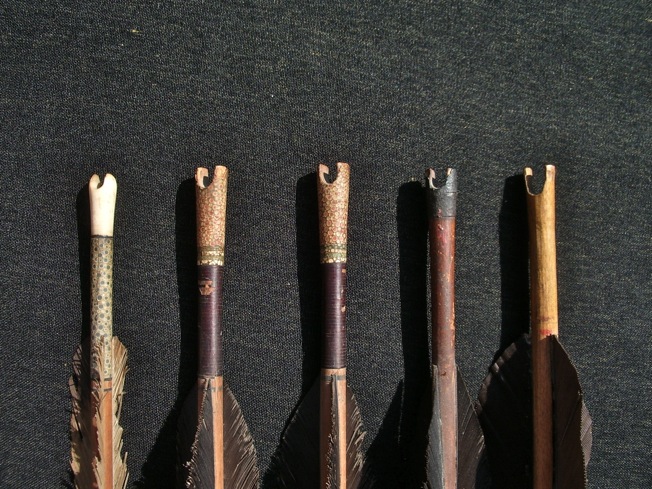
Five nocks from arrows of my own collection. From left to right: Indian style bulbous nock of a target whistle arrow, bone and green ray-skin; two nocks of target arrows, cherry bark and dyed ray-skin; nock of a hunting arrow, black dyed ray-skin reinforcement, military arrow with simple wooden self-nock.
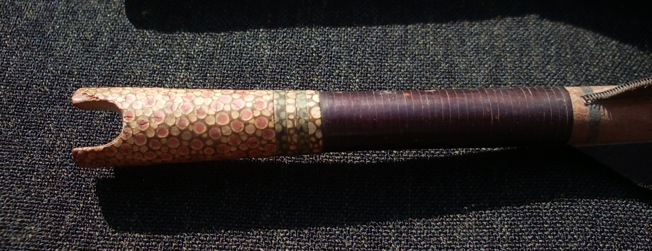
Close-up of a nock of a target arrow with cherry bark wrapping and three colors of ray-skin.
Feathers
Manchu arrows are usually fletched with feathers of vulture, eagle or stork feathers. The fletchings are typically quite large in order to stabilize the arrow quickly. We can see a trend where feathers got longer during the course of the dynasty, while distances shot at the military examinations got correspondingly shorter. In order for an arrow to hit with its full kinetic potential, it is important that it hits with the nock neatly aligned behind the head. The larger the feathers, the earlier in flight the arrow is well-aligned. So an arrow with big feathers can do a lot of damage on very short ranges already, where a conventional arrow needs some time to get well aligned. But larger feathers also cause drag and thus reduce the distance an arrow can fly. I think the most likely reason for the change in feather length from the early to late Qing was due to the change in distances shot. When firearms more and more took over the longer ranges, I think the Manchu bow more and more got specialized in short distance effectiveness. The fletchings can be straight or helical, and are usually fletched in one of three ways.
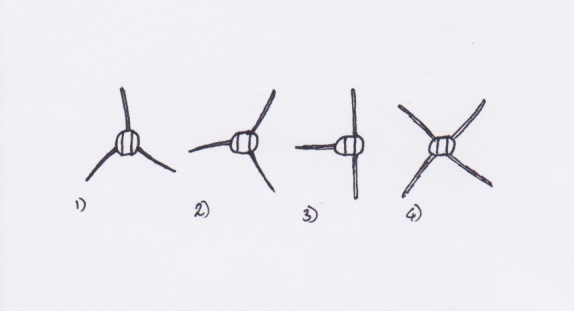
The four most common feather placements on Manchu arrows. 1.) One feather points up, two diagonally down. The idea being that however one nocks it, there will always be only one feather rubbing the bow. A typical Asian way of fletching. 2.) The "cock" feather points outwards. With this layout the two feathers on the right (as seen is this illustration) may sometimes be spaced a little wider apart. 3.) Here two feathers are in line with the string, often, feathers of opposing wings were used that were ironed completely straight. One feather points away from the bow. The idea is that the up and down pointing feathers deal with the first fish-tailing of the arrow, it works really well. Another advantage is that from feeling the feathers, one will know where the nock is. 4.) The least common method is the four-fletched method, all feathers are diagonal in relation to the string. Ideal for horseback archery, it doesn't matter how one nocks this arrow at all.
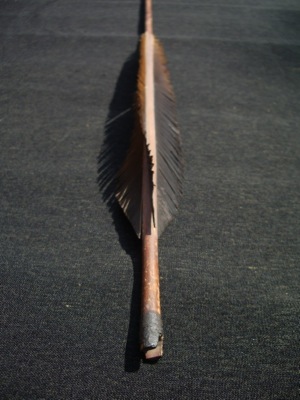
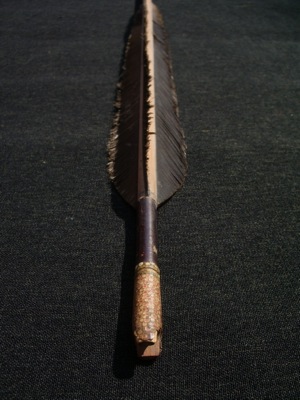
Left: the tail of a hunting broadhead arrow with twisted fletchings. Right: the straight fletchings on a target arrow's tail. Author's collection.
Heads
The standard military head was the meizhen "plum needle" (梅針), which was a sharp head of 13-15mm wide on a long neck. The greatest variety of arrowheads were hunting heads, mostly a variety broadheads, called pi (鈚). They come in a wide range of shapes and sizes, from chisel to leaf shaped, to crescent moon shapes. Manchus were masters of whistle arrow development, with a wide variety of very clever designs. The subject is so broad, it deserves an article in itself which I will publish in due time. Whistling arrows come in two general types, those with only a whistle, and those with a whistle behind an otherwise regular arrowhead, usually a hunting broadhead. They were used for signalling, sports, but by far most Manchu arrows with whistles were used for hunting. The idea was that the animal was startled by the whistle, stoping in its tracks from the moment of release, making them easier to hit. Another group of arrows are "forks" with prongs used to shoot fish or small game. Another group had thick solid heads for practice, or small game hunting, killing by blunt force. Lastly, there were target arrows. Target arrows are usually of rather high quality because they were typically meant to last and to be re-used.

The heads of five Manchu arrows. Left to right: military head, whistle head, target head, hunting head, hunting head. Author's collection.
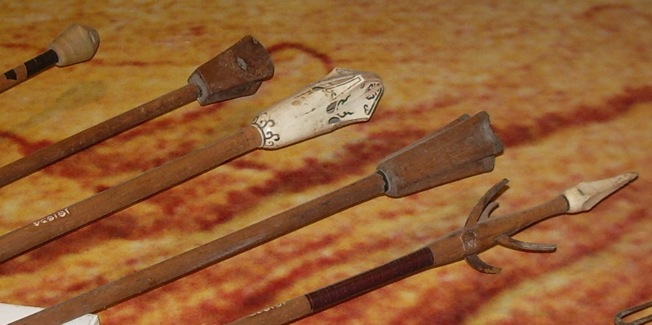
Some special Manchu arrows. Left to right: target whistle arrow, square whistle arrow, ceremonial whistle arrow, blunt hunting arrow, hare fork arrow. Collection of the Military Museum, Beijing.

Some antique Manchu military arrowheads. Author's collection.
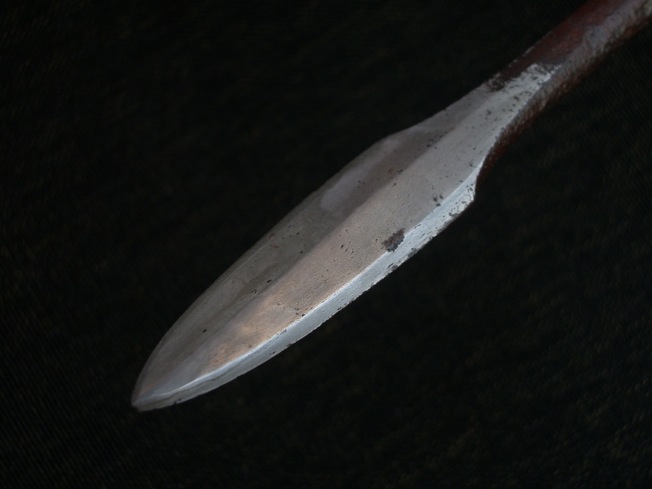
A military "plum needle" (梅針) Polished by Philip Tom to reveal its layered steel construction, just like a sword. Author's collection.

A late 19th century Manchu arrow. From the collection of Daniel Hu. Photo by Daniel Hu.
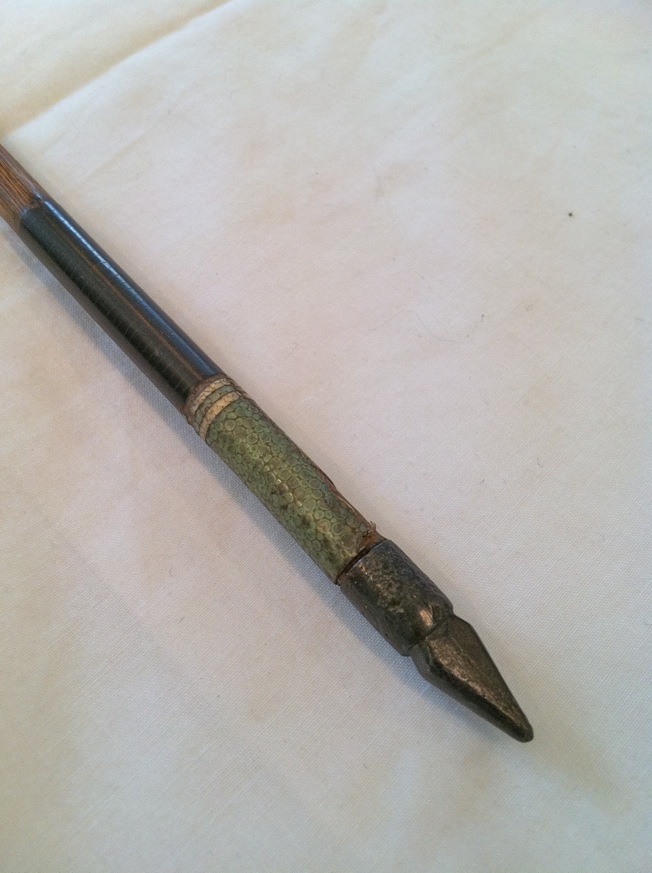
The tip of a high quality Manchu target arrow, with ray-skin and cherry bark wrappings behind the precisely shaped steel head. Ingo Simon collection, Manchester Museum archery collection.


